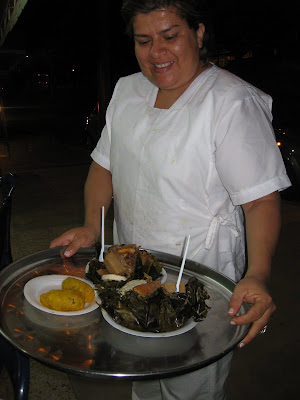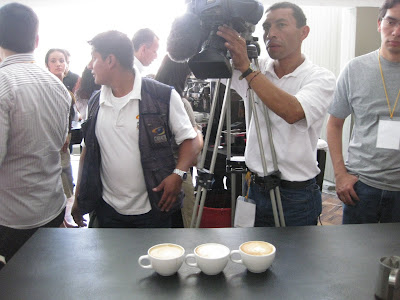
La Lechona in all its' glory.
Sometimes I wonder if there isn't some kind of force working on us during these trips, steering us away from comida typica that I seek. It was the very kind Alfredo that brought us to the famous lechona restaurant somewhere in Ibague where promises of roasted pig were about to be fulfilled.
The lovely part of visiting Latin America is that they too love roasting pigs. Growing up Filipino, it wasn't uncommon to find pig on a spit spinning in the backyard. Of course, when I was really young we didn't like the fact that our fathers killed the cute pig but it was a scar that would have to remain in the face of porcine tastiness.
Once in a while, I worry about whipping out the camera wherever we go to take pictures of our food. It's weird and freakish and perhaps even off-putting to Latinos who are probably expecting all sorts of tomfoolery from gringos. But when the camera came out, the proprietor seemed more than happy not only to allow me to take pictures but to give us the grand tour as well.

The in-house butchery.
Moments later, we were descending the stairs into some dark basement where the true secret of Lechona lived. In the belly of this concrete beast lay a massive wood-fired oven where ten pigs had laid to rest for their ten hour slumber at low temperature where their muscles would break down into moist, stringy goodness and their skins would crisp into chicharron.
Coconut husks were used to start the fire while peas and assorted herbs are used to stuff and flavor the pigs. To one side of the room is a concrete table where rubber aprons are hung nearby - the sign of butchery. While the pigs aren't slaughtered here, they are prepared and finished here and you can't help but think slightly grotesque images of pigs being disemboweled as their guts and blood run onto the table surface before being collected for the house morcilla.

More Lechona making their ten hour journey in the oven.
Peering into the oven and seeing the pigs lying in their individual metal pans, I can't help but think that this resembles some sort of funeral pyre. Their eyes closed and they seems so at peace. I'm genuinely touched.
Back upstairs, Senora Guzman is preparing our Lechona while I peer into the outside lit display case housing such wares as empanadas, sausages and the mysterious looking dried pulmon or cow's lung.

Dried Pulmon - cow's lung.
Cow's Lung. Pulmon. It looks like it could be dried liver, or some sort of random dried thing. Lung. My God, who eats lung? I think of the inedible lung/gills of a blue crab. I think of the texture of the human lung. I think that the idea of eating lung is disgusting. But obviously Colombianos eat lung because it's here and in a large pile. I can't think not to eat it without actually trying it for myself. I ask Alfredo to ask the Senora if we can just sample one, she grants my wish.
Pulmon. It looks like dried Philippine Beef Tapa - marinated strips of skirt steak dried on racks in the sun. I conjure the Philippine Gods of Beef Tapa in the hope the flavor of the beef lung is the same. It isn't.

One must never let the frontier go unchallenged.
Actually, it's quite difficult to describe the experience. Lung seems to be one of those things that, unless you've experienced it yourself, it's hard to have a reference point. It's neither mealy nor smooth. Nor pasty or coarse. It's lung and the flavor isn't despicable. In fact, with repeated portions, and some salt and vinegar, Pulmon could become an infrequent favorite, like Filipino Balut (that nearly developed duck egg/embryo that's boiled and sucked on) - and a big pile of steaming white rice. In fact, I can eat almost anything with a big plate of steamed white rice.
Finally, our Lechona makes its' grand entrance. Rouki (the smart one of the group) went for the pequeno plate. I went for the medio plate, and Rodrigo went for the grande plate. Though, if I was smart, I would have gone for the small (pequeno) plate like Rouki. The medium plate was too much.

Morcillo and Arepas.
Lechona is the meat piled on with the stuffing of peas and herbs. It's a delicious combination but I found some pieces of meat to be drier than the others, making the moistness of the meat imbalanced. Don't get me wrong, it's still very good.
The meal is served with a kind of corn jelly that reminds me of the Hawaiian dessert called haupia. My understanding is that you take the corn Harina and mix it with sugar and water and it creates a paste that you bake and it gels and solidifies into a kind of hard gelatin texture. The texture and result is very similar to the haupia without being as sweet and dessert-like. Whatever the case, it a perfect counterbalance to the fattiness of the pork.

La Maestra presents us more of her work before delivering them to another table.
The common side in Colombia seems to be the Arrepa or Arrepita - thick, corn discs very similar to the corn disks of the Mexican sopes. But aside from the arrepitas at the Mercure Hotel, I'm finding them to be pretty dry and bland (we think the Mercure makes theirs with butter). Add a bottle of Coca-Cola and all is well in Lechona Land.
Awhile later, Senora Guzman comes by our table with a tray full of orders for another table. She's proud of her work and wants us to have a glance at the items before they're delivered to their rightful patrons. She also comes by to drop off an complimentary order of morcilla, a Colombian blood sausage stuffed with rice.

La Lechona.
The morcilla is dark and angry-looking. So dark, it looks sinister. Overall, I'm not a big fan of blood sausage. I've tried it numerous times and have only liked it once. For me, it's that kind of livery-mealy texture that gets me. But we're in Ibague trying new things and I'm not going to say no to blood sausage - especially since the one example that I did like, I found to be delicious. I hoping that this morcilla will be to my liking.
This morcilla has nice flavor and the inclusion of rice is something I've never experienced before but that mealy, grainy texture is there and I'm afraid I'm not a fan. I'm ashamed because this was Senora's gift to us - an expression of their love for their craft and it's not to my liking.

Chicharron!
As we sit in the warmth of the hot Ibague summer night, I'm comforted by the fact that we're eating good pig and surrounded by good friends. When I think back on it, it's kinda strange for me to travel with friends since I seem to do so much traveling alone. Rouki and I have been to Africa, Central America and Europe on trips and adventures and I know there will be more, and I'm hoping that Rodrigo, Alfredo and Carolina will be able to join those future adventures as well.
Aisen Guzman Arias
Lechoneria lo rico de Eduvina
Urb. La Esperanza Mz B Casa 9
Ibague, Tolima
Colombia
271 59 98














